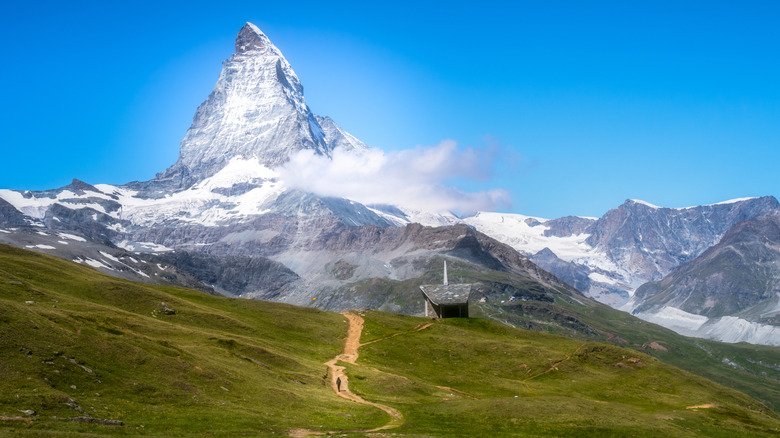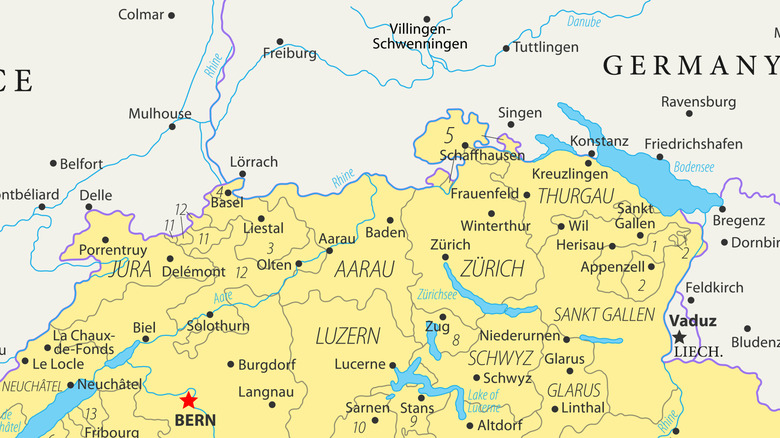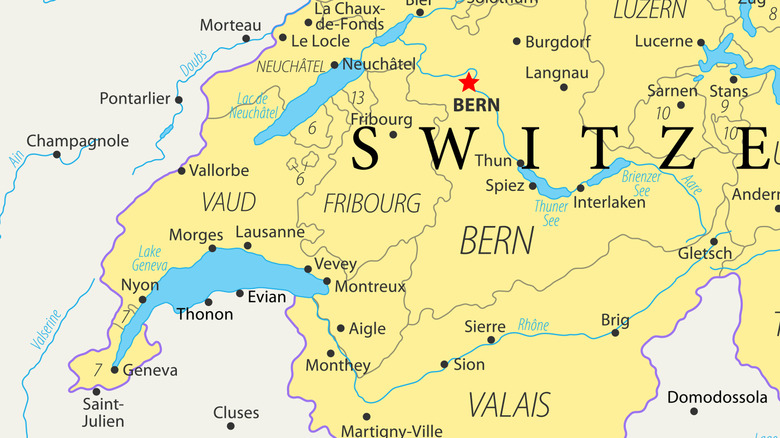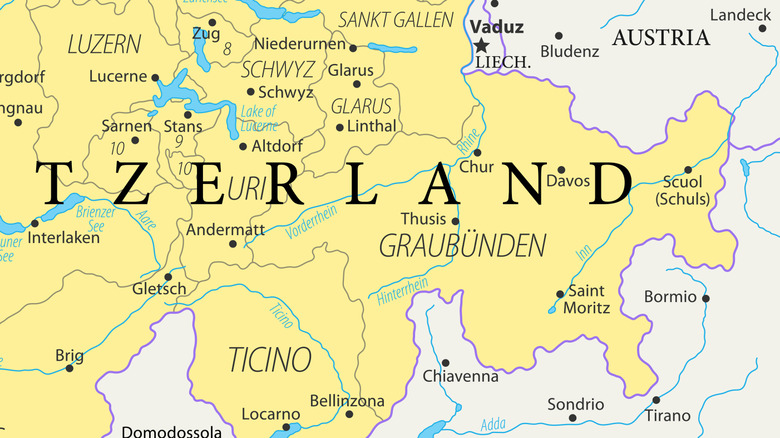The Only Map Of Switzerland You Need For Your Upcoming Trip
When you think of Switzerland, your mind probably conjures images of watches, cheese, chocolate, picturesque mountain villages, and the majestic Matterhorn, the 2.8-mile-high pyramid-shaped peak with the highest mountain station in Europe. The country, bordered by Italy in the south, France in the west, Germany in the north, and Liechtenstein and Austria in the east, has endless views worthy of a postcard. If you're visiting, however, there is so much more to see beyond the things that immediately come to mind.
Switzerland isn't part of the European Union (EU) or the European Economic Area (EEA), but it's part of the single market, allowing people, money, and goods to move freely between EU countries. That means they don't use the euro, so if you're traveling between countries in the area, it's important to keep currency in mind. Switzerland uses the Swiss franc (CHF). However, prices in stores are sometimes marked in both CHF and euros, and you may even be able to pay in euros, though you might receive Swiss francs in change. You should also know that while tipping isn't quite like it is in America, it's still customary to leave around 10%. There are four official languages spoken in Switzerland — German, French, Italian, and Romansh — so have Google Translate handy. Major airports include Zürich Airport, Geneva Airport, and Basel Airport. You can rent a car, but you might want to skip that and travel around the country by train, boat, or bus. You can pick up a Swiss Travel Pass for three, four, six, eight, or 15 consecutive days, so you have freedom of movement around this beautiful country.
The northern region of Switzerland
In the northern region of Switzerland, you'll find the city of Zürich, which has the cleanest air in the world. It's the largest city in Switzerland and its financial heart, making it the perfect place to start your Swiss journey. Here you'll find a town full of modern conveniences as well as historical architecture, particularly in the old town section along the Limmat River. However, if you'd like to see it from above, you can visit the Lindenhof, the green space in Zürich's center with spectacular views. While you're in town, make sure to visit the beautiful, neo-Gothic Grossmünster, the seat of the Reformation in the 16th century. You can take a public or private tour, see the paintings and architecture inside, and even climb the clock tower. Elsewhere in the city, you can take a boat out, swim, or simply enjoy the breezes on Lake Zürich. You're also close to the Lindt Home of Chocolate, where you can attend a workshop by a master chocolatier, tour the museum, and, of course, indulge your inner chocoholic.
Also in the northern region is Basel, home to almost 40 museums, including the famous Kunstmuseum Basel, and a beautiful Old Town. This is the perfect place to take a walking tour to get to know the area. One place you have to hit is Basler Münster, the gorgeous cathedral with two breathtaking towers on top. Underneath is a lovely plaza where you might end up catching a concert. Also in the north near Schaffhausen is Europe's largest waterfall, the Rhine Falls. This awe-inspiring natural wonder is so powerful that you can feel the vibration of the water crashing down. You can take a boat trip along the river to see it and even climb the Mittelfelsen, the large rock in the center.
The southern region of Switzerland
If there is one spot in Switzerland that you cannot miss, it's Zermatt, with the iconic Matterhorn in the background. The town itself is car-free, and it's fantastic for outdoor activities. You can go hiking in the mountains around Gornergrat (though make sure you know what to do if you get altitude sickness), and see the peaks reflected in Lake Riffel. Skiing is king here, and you can actually climb the Matterhorn, though only experts should try it. Take the cable car up to the Matterhorn Glacier Paradise with its glacier palace, viewing platform, and a restaurant in the clouds. You can even do some summer skiing and shopping. Speaking of shopping, you should leave time to explore Zermatt's Bahnhofstrasse, which has plenty of charming boutiques and restaurants.
If you love the outdoors, don't miss Interlaken. It sits between Lake Thun and Lake Brienz, and hitting the water on a kayak is a recipe for the perfect day. For an unusual treat, you can rent a floating hot tub in Lake Brienz that allows you to soak in warm water as the chilly lake air surrounds you. In the town, you can also head to Giessbach Falls and walk a path underneath the rushing water.
On the southern side of the Alps, between Zürich and Italy's Milan, you'll find the lakeside villages of Ascona and Locarno. This spot combines the charms of both Switzerland and Italy, with the beautiful Lake Maggiore which goes over the border. You can do some mountain hiking and skiing, or, if you're visiting in the summer, make sure to check out JazzAscona, the jazz festival in the city. Also, take some time to explore the enormous Piazza Grande in Locarno and hit the August film festival if it aligns with your trip dates.
The western region of Switzerland
In the western part of Switzerland sits Lausanne on Lake Geneva, home to the International Olympic Committee. Walking through the Old Town, you can see the Gothic Notre-Dame Cathedral, finished in the 13th century and featuring an incredible pipe organ. During the day, you can wander Hermitage Park for some peace and quiet, or visit Sauvabelin Park's artificial lake. You might even spot some woolly pigs and goats there. Then, head to the Olympic Museum to learn about the history of the games.
Make sure to hit Bern, with its Old Town, declared a UNESCO World Heritage site in 1983. With charming buildings made of limestone, this 12th-century city features the Zytglogge, or Clock Tower, that delights visitors every hour with a puppet show. You can take a tour of the clock and get a phenomenal view of the town from above. You should also take a bike out on the 888 Grünes Band Bern, the 36-mile loop around the Bern area, with signs along to way to help you understand the area.
Also in the west on Lake Geneva sits Chillon Castle, dating from the 12th century. It was once home to the counts of Savoy, and it's a beautiful place to visit. You can see a 14th-century mural, Gothic windows, vaults below the castle, a display of beautiful furniture, and more. There are both guided and self-guided tours and Café Byron, where you can enjoy a meal. In the southwest of Switzerland is Geneva, where Swiss watchmakers became famous in the 16th century. You can't miss the city's Jet d'Eau, a huge water jet that was created to relieve water pressure from the local industry. It's especially beautiful when lit up. Geneva is also the home of the European Organisation for Nuclear Research (CERN) and the Large Hadron Collider, which you can visit and tour for free.
The eastern region of Switzerland
In eastern Switzerland, Saint Moritz is the main tourist spot. Famous for ski resorts like Corviglia and Diavolezza, this town along Lake Saint Moritz has scenery right out of a coffee table book. The Swiss National Park in Engadin is the perfect place for hiking with 60 miles of trails, as well as animals like ibexes, marmots, and chamois. Summer visitors to Saint Moritz can enjoy sailing and windsurfing on the lake, but winter is when this destination really shines. Do some hang gliding from the Corviglia summit down to the frozen lake, and after your outdoor activities, you can hit the Via Serlas street for some shopping.
Skiers will also want to visit Davos, north of Saint Moritz, where you can visit Bolgen Park. The ski resort is not only fantastic for swooshing down the slopes, but it's also a famous spot to experience a halfpipe. On Friday nights, they light up the area for a unique, nighttime skiing experience. Take the Schatzalp funicular up to Hotel Schatzalp, over a mile above sea level. Quiet and serene, this area was the inspiration for Thomas Mann's "The Magic Mountain." There are outdoor sports like tobogganing and a botanic garden to wander. Finally, near the border with Liechtenstein, Glarus sits on the Linth. Mountain hiking is a draw here, as is the lovely Lake Klöntal. You should make time to visit Braunwald, the car-free village nearby. You can climb up or take the funicular to explore this place. If you have kids with you, visit Glarnerland in Braunwald, an area that allows them to explore a magical forest playland and hunt for Bartli the Dwarf.




